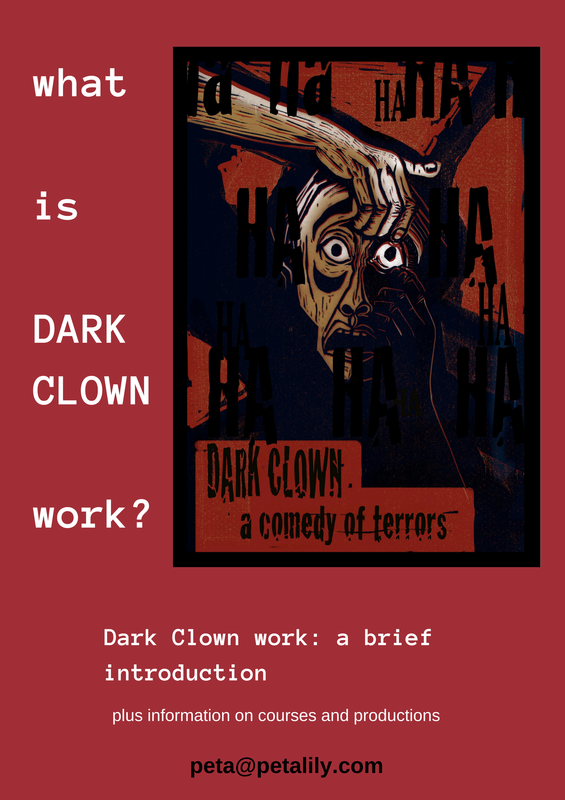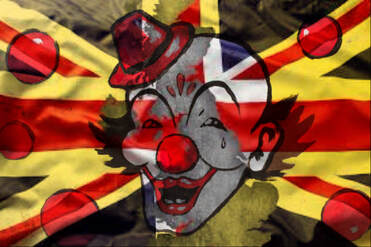
I was hired by a Drama School. I had just a few days in which to teach a group of acting students Clown, and to also create a Clown performance.
The teaching was going well and on Day Two, as time was short, I decided to offer the idea that was visiting itself upon me. I would, as ever, ask for the students' improvisations, ideas and contributions but it's good to have a framework to glue it onto. I checked that they had no other ideas to put forward and that they found the idea appealing to play inside.
Title: Klown-zit. It's a twist on, but not an allegory for Br*xit. It would also follow a recurring interest of mine in the marginal nature of Clowns, by which I mean Clowns under threat.*
The Clowns are leaving - they have prepared this presentation as their last show, before taking themselves away and leaving us Sad Normals without them.
For the first show-oriented exercise, I divided the group in two and set them each to improvise a Clown Funeral (classic clown trope - there is a lovely take on this in the 1924 film He Who Gets Slapped). I thought I'd choose one improv or perhaps amalgamate the best ideas from either group into it. They were both strong ideas and the two groups had each worked well together. Great, a problem - two versions of a funeral, yes, we'll use them both and make that work!
One boy was ill and absent for a day or two and on his return, I wanted to find a way to let him feature. I asked the group if they could find a cardboard box - or any kind of box. Ultimately, on show night, he was stationed on stage as the audience waited for the show to begin, holding a shoe box, wearing smart black pants, a white shirt and a sombrero.
Sombrero Clown: Hello Madam, would you like to make a contribution?
You sir? Would you like to make a contribution?
All contributions welcome.
Thank you Madam. Thank you there. Thank you.
Whenever audience members laugh – he opens and closes the box lid to ‘capture the laugh’. The inside of the shoe box reads ‘Laughter Bank.’ He holds it like it's precious.
A group of clowns enter. They are singing the Wedding March. They carry aloft a bear who has a red nose and big shoes (red trainers on its feet). They gather in a small U shape around the bear which is now on the floor.
Clown with an air of authority: Any last words?
Spotted Clown: Words.
Minnie Mouse Clown: Words.
Clown with an air of authority: (a touch long-sufferingly) Thank you. Any more last words?
Pyjama-clad Clown: Yes.
They turn to look at him.
Pyjama-clad Clown: Oranges … (they nod, with varying degrees of certainty) Dave … (they nod as before) ... Knees. (they nod - either touched, or relieved it's over).
Another group enter, including two angel clowns – they are singing the Death March.
Minnie Mouse Clown: Oh no, we ‘ve been singing the wrong song!
They hold a clown aloft with a gurning death face (tongue out). She opens her eyes and winks at the audience as they cross the stage in front of the first group and resumes her death face. The Death March goes into double time. They place the Goofy gurning clown on the floor and circle sombrely. Someone places a rubber chicken on her chest like a flower. The angels throw tinsel. Group two start to cry. They huddle to cry. The first group of clowns, who have been feeling inadequate and wrong, are suddenly also overcome and join the crying circle too.
The 'dead' clown raises her head - looks at the group. Her interest is piqued. She approaches, then is overcome, wailing louder than them all.
Clown with an air of Authority notices, congratulates the troupe of clowns: 'Well done, well done!' Shakes hands with Goofy, then turns to the audience to address them. He is flanked by Spotty Clown and the Goofy 'dead' clown.
The Authority Clown: Good Evening and welcome to Klown-zit.
A colourful cardboard sign with Klown-zit written on it is unfolded and held up.
One of the angel clowns who is actually quite curt and bossy takes over: 'People think that Clowns are stupid and can't do anything properly.' This prompts a series of ridiculous routines including spaghetti being cooked with one clown contorting herself into everything from sink to stove to kitchen table.
The curt Angel: ... And some people think Clowns are Scary ...
PJ Clown has a moment of terror when his shark slippers come alive. He runs around the stage and clings to another clown for safety - when he looks up, Spotty Clown is doing her best impression of the balloon-holding 'Pennywise'. The moment is defused by the balloon being released and farting round the room.
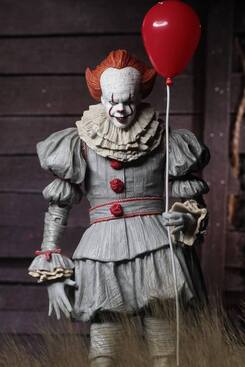
The clowns come in pairs delivering lame jokes (one does the set-up and the other
does the punch).
A man goes to the doctor because he has a clown growing out of his neck.
- The doctor tells him, “Don’t worry, it’s nothing serious.” Boom tish
Why don’t cannibals eat clowns? - Because they taste funny. Boom tish
How big is a clown’s hard drive? - 50 Gigglebytes. Bada ba flop
Two cannibals captured and killed a clown. - They made a laughing stock
out of him.
What’s left of a clown after a bear attack? - Just his funny bone.
Clowns can no longer afford their balloons… - Because of inflation.
Did you ever hear about the unlucky clown? - He tried ten times to make
the audience laugh, but no pun in ten did. Get it? No pun in ten did … No pun in …
What is the gooey red stuff between an elephant’s toes?
... Slow clowns.
There is an act that combines juggling and percussion with a metal tea tray.
There is a sweet interlude when the PJ clown and Minnie Mouse do a version of the leaving song from The Sound of Music with the Teddy bear animated like a puppet: "So long farewell, adieu adieu adieu ..."
Authority Clown returns with his henchmen.
So - we bring you all of this (indicating the stage) - music, surprises, colour.
Will you miss us?
Because we're going now.
Klown-zit means Klown-zit.
We've had enough.
We see the way you look at us. We hear you thinking:
'Their hair is too big, their shoes are too big.
Their voices are too squeaky.
Their clothes are all wrong.'
He starts to speak as if in a big tunnel and the henchman clowns make an echo effect.
People think Clowns (clowns clowns clowns)
Are chaotic (otic otic otic)
But it's you, (oo oo oo)
the Sad Normals - (ormals ormals ormals)
You (oo oo oo)
are the Chaos (aos aos aos)
Bringers (ingers ingers ingers)
and
we
are going (going going going)
Carousel music starts to bleed in and they make a double circle, beautifully gliding up and down like gorgeous horses on their shining brass poles ... after a few circuits, they peel off and leave, still in merry-go-round mode ...
The lights dim - the Sombrero Clown is last to leave - he pats his laughter bank as if comforting it and hugs it close as he goes.
Applause.
Bright lights up and joyful circus music and the clowns cascade one by one back onto the stage with a dazzling display of acrobatics (and the odd rather lame roly poly). In a line they wave, and lead again joyfully off with kicks and kisses
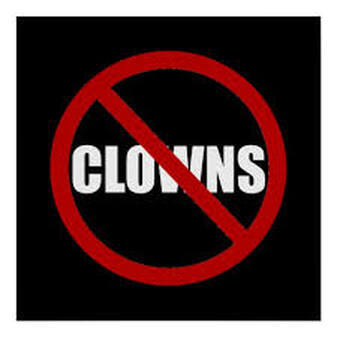 ... when preparing for The Death of Fun, I googled 'no clowns' and a host of images like this came up - try it yourself ... ... when preparing for The Death of Fun, I googled 'no clowns' and a host of images like this came up - try it yourself ... | * Many years back, I led a workshop for the Theodora Clown Doctors in the UK as they were facing their rebranding as Giggle Doctors. The reason being that the organisation was becoming aware that the public (or some of them) were reporting that their children didn't like or were afraid of Clowns. No one can say with exactitude what the contributing factors are, but the Clown-horror movies such as 'It' (and it's more recent remake may well be part of it. There was the unfortunate scary clown pranking happening around the country in both UK and USA, plus there was the most unfortunate set of muggings and acts of actual violence by young men dressed in scary clown gear that happened in France in 2014 - all of which contributed to the premise of Clown play The Death of Fun devised and directed in Hong Kong in 2017. Since Br*xit was mooted, we have seen a lamentable rise in us-and-them thinking and also in hate crimes. This was a Red Nose Clown piece but I do enjoy observing that cross-over area, where we love to see and sometimes laugh ruefully at seeing the Red Nose Clown suffering. I like using Red Nose Clown as a way to illuminate the absurdity in life, the tragedy in life, the poignancy in life. |
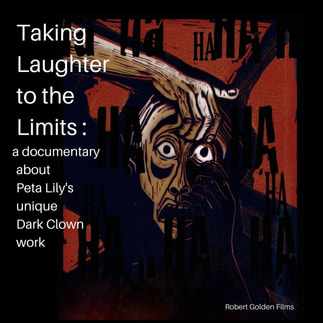
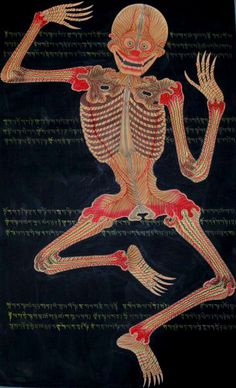
 RSS Feed
RSS Feed
